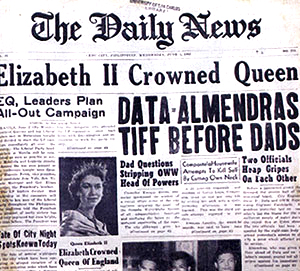The Commonwealth Period
 IT was a period of nationalist triumph, and the pursuit of independence acquired a touch of reality with the provision in the Tydings-Mcduffie law that said the Philippines will be granted its sovereignty in July, 1946. The day in November 1935 when the Philippines was granted the first step towards its independence and eventual freedom, was a most significant one to the nationalist/politicians who were also journalists in their own right.
IT was a period of nationalist triumph, and the pursuit of independence acquired a touch of reality with the provision in the Tydings-Mcduffie law that said the Philippines will be granted its sovereignty in July, 1946. The day in November 1935 when the Philippines was granted the first step towards its independence and eventual freedom, was a most significant one to the nationalist/politicians who were also journalists in their own right.
From being a Spanish colony for 300 years, and more than a third of the century under American tutelage, the Philippines mass media flourished in a matter of just four decades. The years between 1916 to the start of the Commonwealth in November, 1935, marked the steady decline of Spanish as medium of communication in Cebu. In 1916, Fr. Jose Ma. Cuenco came out with a Cebuano biweekly called Atong Kabilin.
A hiatus of three years ensued, before journalist/poet Vicente Padriga came out with another Cebuano weekly Ang Iwag in 1919. The same year marked the first appearance of an English-Cebuano weekly, The Freeman founded by the Paulino Gullas. This periodical has existed up to now, but recently bought by the Philippine Star. But at that time, it took off with zest, and ceased publication only at the outbreak of the Pacific war.
Again, in 1922 an English-Cebuano daily, The Advertiser, founded by Jose Avila, made its first appearance. This was followed the following year with another English-Cebuano daily, Cebu Daily News of Mariano J. Cuenco. Once more, there was a gap of four years before the bilingual weekly of the Falek family, Star, came out in 1927. Then the first purely English weekly of Vicente Rama called Progress came out in 1928. It was followed with a Spanish-Cebuano weekly El Democrata of politician Nicolas Rafols.
But this appeared to be the dying gasp of the Spanish periodical in Cebu.
From that moment in 1928 up to 1935, there was a deluge of 13 Cebuano publications, the most significant of which were Nasud of Pedro Lopez in 1930, Babaye in 1931 of Napoleon Dejoras, Lungsoranon of the Catholic Church which still circulates in Catholic parishes up to now; And Banagbanag of Maximo D. Bas which appeared in 1935.
Encouraged perhaps by the sense of freedom the vernacular writers felt at the onset of the Commonwealth, some 20 more Cebuano publications made their appearance over the next five years. Looking back on this period, what a raucous mass media environment the Cebuanos may have had, with all those vernacular periodicals fighting for their attention and patronage vying to get their P0.05 to P0.10 from their respective pockets.
But what should be most significant in this five-year period, is the appearance of six English periodicals, two dailies, two weeklies, one monthly and one bi-monthly. Only one Spanish daily of the Escano family contested the mass media market in 1940. The two English dailies, The Cebu Herald in 1938 of Cesar Mercader and The Challenger of Cornelio Faigao in 1940, no doubt served as reading fare of the first Cebuano generation educated in English, and schooled in the public schools of the Thomasites.
The outbreak of World War II in December 1941 stopped the mass media fad in Cebu, and abruptly arrested any plans of more publications or expanding of existing ones. In a word, everything stopped with finality as everyone involved in publishing apparently took to the hills. Of course, it did not stop Pete Calomarde-in whose honor a Cebu City street has been named -from putting out Morning Times, a daily in the hills.
Taken in as the Cebu guerrilla daily, it was initially published in 1943 as a mimeographed set. Later it came out printed in letter press. The paper went on through 1944 and 1945 when it became Cebu's first daily during the liberation. It was later joined in the same year by The Pioneer Press, the daily founded by Alfredo Cruz, a non-Cebuano, together with another non-Cebuano, Angel Anden.
It can be said here that the two founders of The Pioneer Press truly pioneered Cebu's real professional commercial newspaper tradition, in the sense that it was without political orientation, and its goal was to attain profit as purely a commercial daily.